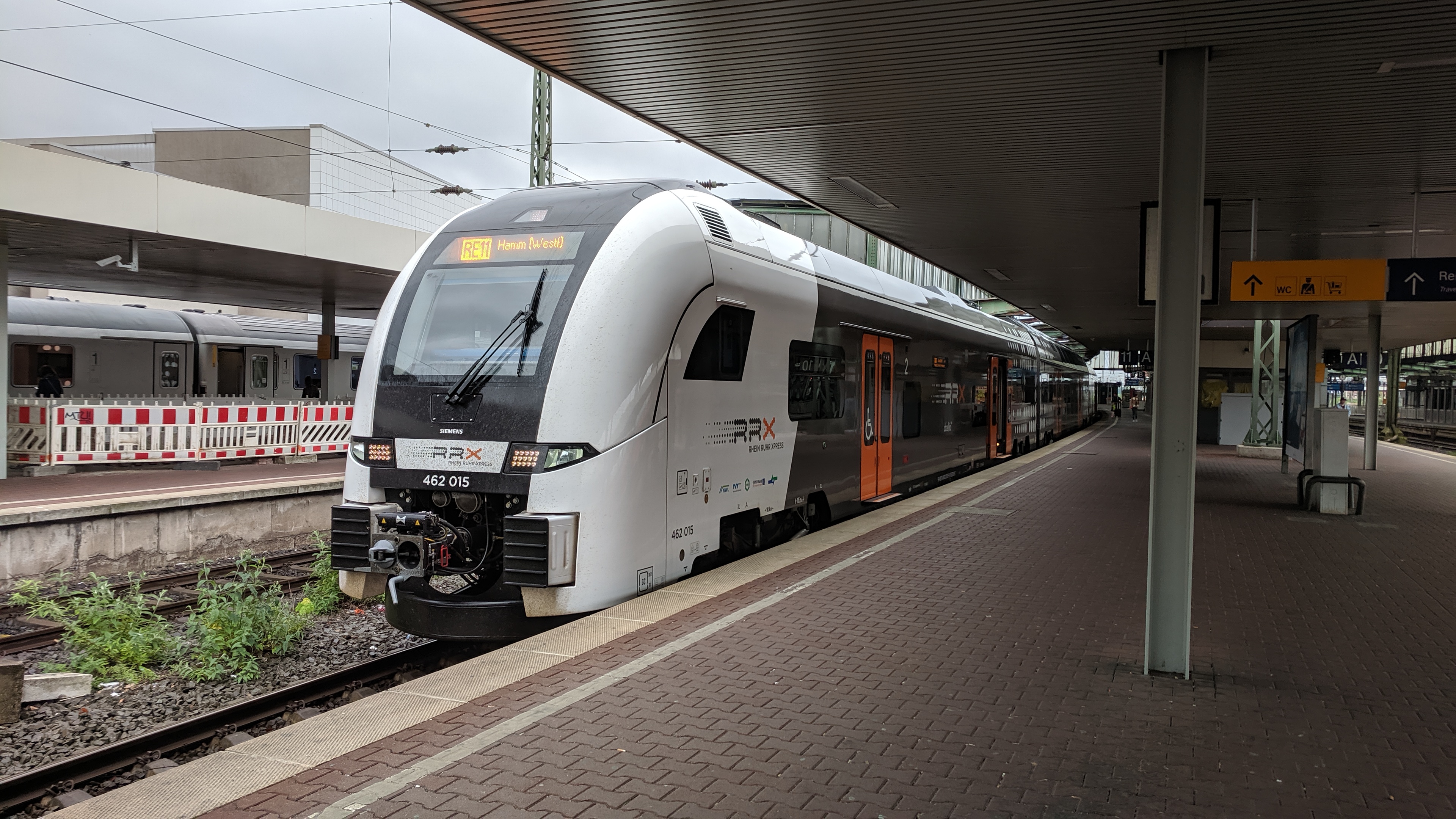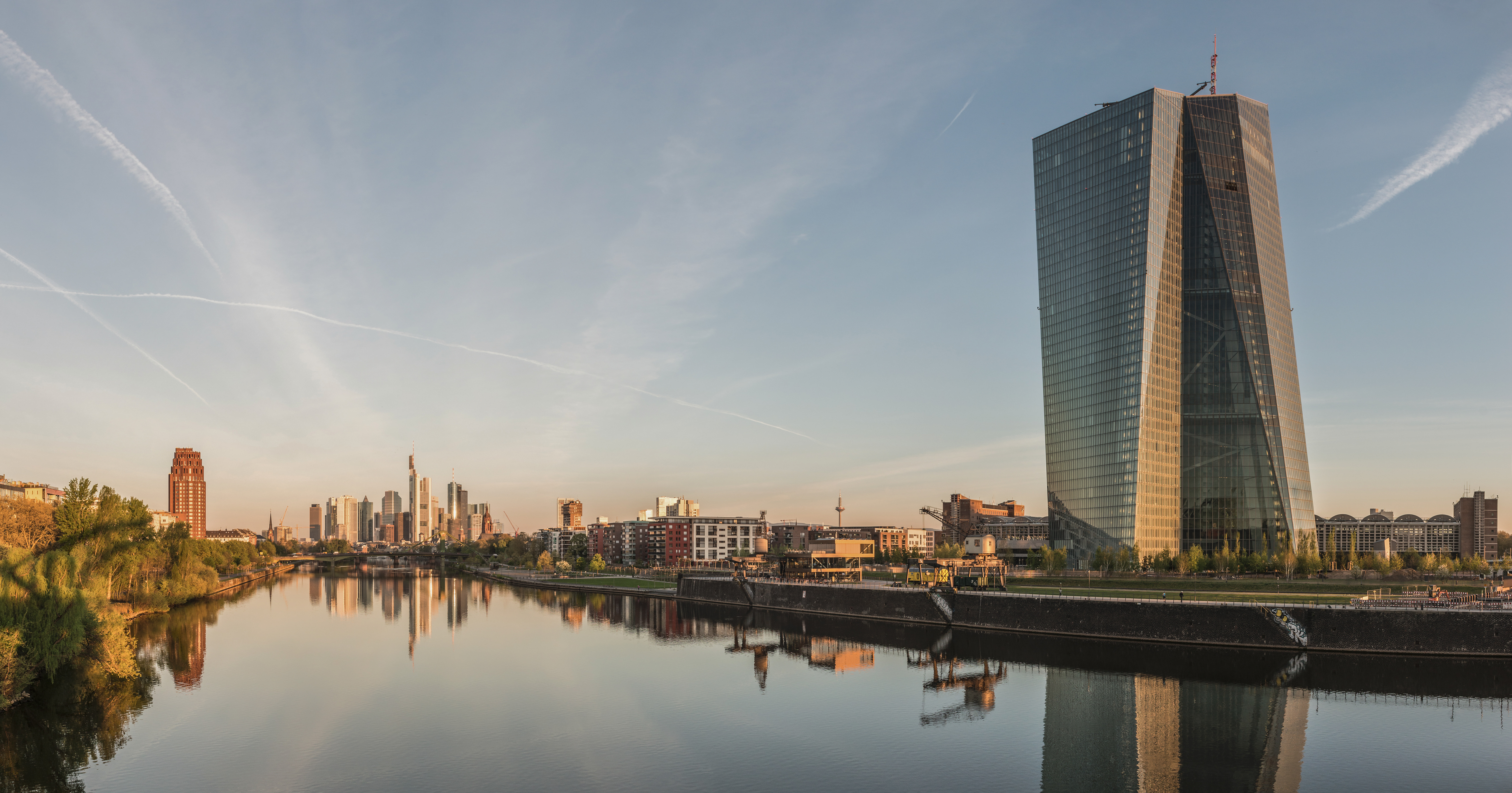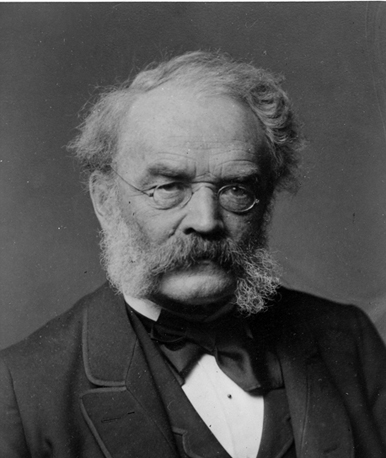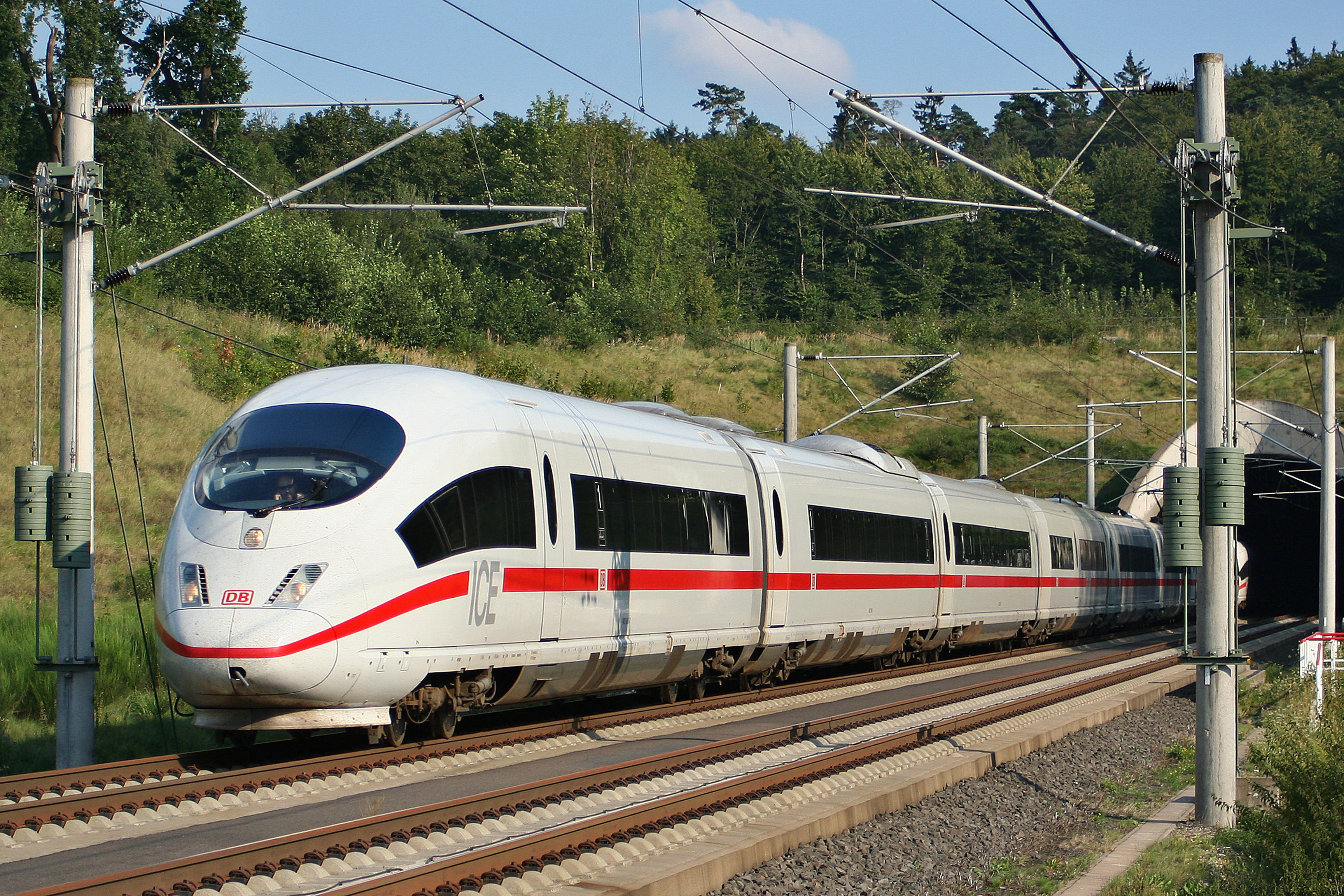|
Rhein Ruhr Express
Rhein Ruhr Express (branded as Rhein Ruhr Xpress or RRX) is a regional rail system in the Rhine-Ruhr metropolitan region of Germany connecting the Ruhr Valley and the central Rhineland. The primary goal is to provide a fast connection on the main trunk line between Dortmund and Cologne, located along the Ruhr Valley, with trains every quarter of an hour. This main line has been expanded, improved or reconfigured to enable more trains to operate and at higher speeds. Like the previous Regional-Express lines they replaced, RRX routes branch off from the main trunk line to serve other cities and states at lower frequencies. For the project, 84 Siemens Desiro HC trainsets were purchased, which have higher capacity and acceleration, enabling increased punctuality. Operation of the first RRX line started in December of 2018, while five lines operate . The construction is planned to be finished by 2030 and the project is expected to replace 24,000 automobile trips per day when finished. ... [...More Info...] [...Related Items...] OR: [Wikipedia] [Google] [Baidu] |
Siemens Desiro HC
The Siemens Desiro (, , ) is a family of diesel or electric multiple unit passenger trains developed by Siemens Mobility, a division of the German Siemens AG conglomerate. The main variants are the Desiro Classic, Desiro ML, Desiro UK and the later Desiro City, Desiro HC and Desiro RUS. The trains are mostly used for commuter and regional services, and their rapid acceleration makes them suitable for services with short distances between stations. The design is flexible, and has become common in many European countries. Desiro Classic Austria Austrian Federal Railways (ÖBB) is using 60 diesel-powered Desiro trains designated as ÖBB 5022. These are based on the Class 642 used by Deutsche Bahn, but have some additional safety equipment. Bulgaria In 2005 and 2006, the Bulgarian State Railways began operating Desiro trains as part of a €67 million deal with Siemens AG for a total of 25 Diesel multiple units. As of 22 March 2006, 16 trains had been delivered, with many of th ... [...More Info...] [...Related Items...] OR: [Wikipedia] [Google] [Baidu] |
Rhein-Hellweg-Express
The Rhein-Hellweg-Express (RE 11) is a Regional-Express service in the German state of North Rhine-Westphalia (NRW), running from Kassel via Dortmund Hauptbahnhof, Dortmund, Bochum Hauptbahnhof, Bochum, Essen Hauptbahnhof, Essen, Duisburg Hauptbahnhof, Duisburg and Düsseldorf Airport station, Düsseldorf Airport to Düsseldorf Hauptbahnhof, Düsseldorf Hbf. It is named after the Rhine and the Westphalian Hellweg. The line is part of the Rhine-Ruhr Express (RRX) network and is operated by National Express Germany, National Express. History In 1988 the first regular interval regional rapid train service was established from Dortmund via Essen, Duisburg and Düsseldorf Hauptbahnhof, Düsseldorf to Köln Hauptbahnhof, Cologne. This operated hourly on the Cologne–Duisburg railway, Cologne–Duisburg and Witten/Dortmund–Oberhausen/Duisburg railway, Dortmund–Duisburg lines, which even then were the most important railway lines for passenger traffic in North Rhine-Westphalia. Wi ... [...More Info...] [...Related Items...] OR: [Wikipedia] [Google] [Baidu] |
Euro
The euro (currency symbol, symbol: euro sign, €; ISO 4217, currency code: EUR) is the official currency of 20 of the Member state of the European Union, member states of the European Union. This group of states is officially known as the euro area or, more commonly, the eurozone. The euro is divided into 100 1 euro cent coin, euro cents. The currency is also used officially by the institutions of the European Union, by International status and usage of the euro, four European microstates that are not EU members, the British Overseas Territory of Akrotiri and Dhekelia, as well as unilaterally by Montenegro and Kosovo. Outside Europe, a number of special territories of EU members also use the euro as their currency. The euro is used by 350 million people in Europe and additionally, over 200 million people worldwide use currencies pegged to the euro. It is the second-largest reserve currency as well as the second-most traded currency in the world after the United Sta ... [...More Info...] [...Related Items...] OR: [Wikipedia] [Google] [Baidu] |
Siemens
Siemens AG ( ) is a German multinational technology conglomerate. It is focused on industrial automation, building automation, rail transport and health technology. Siemens is the largest engineering company in Europe, and holds the position of global market leader in industrial automation and industrial software. The origins of the conglomerate can be traced back to 1847 to the ''Telegraphen Bau-Anstalt von Siemens & Halske'' established in Berlin by Werner von Siemens and Johann Georg Halske. In 1966, the present-day corporation emerged from the merger of three companies: Siemens & Halske, Siemens-Schuckert, and Siemens-Reiniger-Werke. Today headquartered in Munich and Berlin, Siemens and its subsidiaries employ approximately 320,000 people worldwide and reported a global revenue of around €78 billion in 2023. The company is a component of the DAX and Euro Stoxx 50 stock market indices. As of December 2023, Siemens is the second largest German company by market ca ... [...More Info...] [...Related Items...] OR: [Wikipedia] [Google] [Baidu] |
Bi-directional Vehicle , triangle junction, or turntable (railroad), turntable ...
A bi-directional vehicle is a vehicle that can be driven in either direction, forwards or backwards. Usually, the term refers to rail vehicles, such as trains or trams, and some airside transfer buses, that are equipped with driver's cabs at both ends. These vehicles generally have entry and exit doors on either side of the vehicle. One major benefit of bi-directional vehicles is the ability to reverse direction at a terminal station with a stub-end track. On a system using double track, a crossover switch is often used to move the vehicle to the other track. This situation contrasts with the use of uni-directional vehicles, which requires the use of a balloon loop A balloon loop, turning loop, or reversing loop ( North American Terminology) allows a rail vehicle or train to reverse direction without having to shunt or stop. Balloon loops can be useful for passenger trains and unit freight trains. Bal ... [...More Info...] [...Related Items...] OR: [Wikipedia] [Google] [Baidu] |
Multiple Unit
A multiple-unit train (or multiple unit (MU)) is a self-propelled train composed of one or more Coach (rail), carriages joined, and where one or more of the carriages have the means of propulsion built in. By contrast, a locomotive-hauled train has all of the carriages unpowered. An implication of this is that all the powered carriages needs to be controllable by a single engineer or driver, which is a case of the broader concept of multiple-unit train control. In other words, all "multiple units" employ some variation of multiple-unit train control. In the broader context "unit" means any powered rail vehicle, including locomotives (that does not carry cargo) and powered cargo-carrying carriages. In the context of this article, "unit" refers specifically to the latter only (whether the cargo is passengers or some other cargo). What follows is that if coupled to another multiple unit, all MUs can still be controlled by the single driver, with multiple-unit train control. ... [...More Info...] [...Related Items...] OR: [Wikipedia] [Google] [Baidu] |
Duisburg Hauptbahnhof
Duisburg Hauptbahnhof is a railway station in the city of Duisburg in western Germany. It is situated at the meeting point of many important national and international railway lines in the Northwestern Ruhr valley. Lines The station is situated at the northern end of the relatively straight Cologne–Duisburg Railway, Duisburg to Düsseldorf railway line which has to cope with one of the highest daily loads in continental Europe. This line is slated to be widened to six tracks in the near future. Currently it has four—and in some places five—tracks. The Duisburg-Ruhrort–Mönchengladbach railway, line to Krefeld and Mönchengladbach runs to the south. This crosses the Rhine, River Rhine and then splits into the main line and a branch to Moers and Xanten at Rheinhausen. North of the station, seven tracks run to the Ruhr (river), River Ruhr crossing (which is a sight on the ''Route der Industriekultur'' (Route of industrial heritage) due to a maze of girder bridges) where Ob ... [...More Info...] [...Related Items...] OR: [Wikipedia] [Google] [Baidu] |
Düsseldorf Airport
Düsseldorf is the capital city of North Rhine-Westphalia, the most populous state of Germany. It is the second-largest city in the state after Cologne and the seventh-largest city in Germany, with a 2022 population of 629,047. The Düssel, from which the city and the borough of Düsseltal take their name, divides into four separate branches within the city, each with its own mouth into the Rhine ( Lower Rhine). Most of Düsseldorf lies on the right bank of the Rhine, and the city has grown together with Neuss, Ratingen, Meerbusch, Erkrath and Monheim am Rhein. Düsseldorf is the central city of the metropolitan region Rhine-Ruhr, the second biggest metropolitan region by GDP in the European Union, that stretches from Bonn via Cologne and Düsseldorf to the Ruhr (from Duisburg via Essen to Dortmund). The ''-dorf'' suffix means "village" in German (English cognate: '' thorp''); its use is unusual for a settlement as large as Düsseldorf. Linguistically, Düsseldorf is ... [...More Info...] [...Related Items...] OR: [Wikipedia] [Google] [Baidu] |
Island Platform
An island platform (also center platform (American English) or centre platform (British English)) is a station layout arrangement where a single platform is positioned between two tracks within a railway station, tram stop or transitway interchange. Island platforms are sometimes used between the opposite-direction tracks on twin-track route stations as they are cheaper and occupy less area than other arrangements. They are also useful within larger stations, where local and express services for the same direction of travel can be accessed from opposite sides of the same platform instead of side platforms on either side of the tracks, simplifying and speeding transfers between the two tracks. The historical use of island platforms depends greatly upon the location. In the United Kingdom the use of island platforms on twin-track routes is relatively common when the railway line is in a cutting or raised on an embankment, as this makes it easier to provide access to the platf ... [...More Info...] [...Related Items...] OR: [Wikipedia] [Google] [Baidu] |
Side Platform
A side platform (also known as a marginal platform or a single-face platform) is a platform positioned to the side of one or more railway tracks or guideways at a railway station, tram stop, or transitway. A station having dual side platforms, one for each direction of travel, is the basic design used for double-track railway lines (as opposed to, for instance, the island platform where a single platform lies between the tracks). Side platforms may result in a wider overall footprint for the station compared with an island platform, where a single width of platform can be shared by riders using either track. In some stations, the two side platforms are connected by a footbridge or tunnel to allow safe access to the alternate platform. While a pair of side platforms is often provided on a dual-track line, a single side platform is usually sufficient (trains are usually only boarded from one side) for a single-track line. Layout Where the station is close to a level crossing (g ... [...More Info...] [...Related Items...] OR: [Wikipedia] [Google] [Baidu] |
Leverkusen
Leverkusen () is a city in North Rhine-Westphalia, Germany, on the eastern bank of the Rhine. To the south, Leverkusen borders the city of Cologne, and to the north the state capital, Düsseldorf. The city is part of the Rhine-Ruhr Metropolitan Region, one of Europe's largest urban areas. With about 163,000 inhabitants, Leverkusen is one of the state's smaller cities. The city is known for the pharmaceutical company Bayer and its sports club Bayer Leverkusen. History The heart of what is now Leverkusen was Wiesdorf, a village on the Rhine, which dates back to the 12th century. With the surrounding villages which have now been incorporated, the area also includes the rivers Wupper and Dhünn, and has suffered a lot from flooding, notably in 1571 and 1657, the latter resulting in Wiesdorf being moved East from the river to its present location. During the Cologne War, from 1583 to 1588 Leverkusen was ravaged by war. The entire area was rural until the late 19th century, whe ... [...More Info...] [...Related Items...] OR: [Wikipedia] [Google] [Baidu] |






